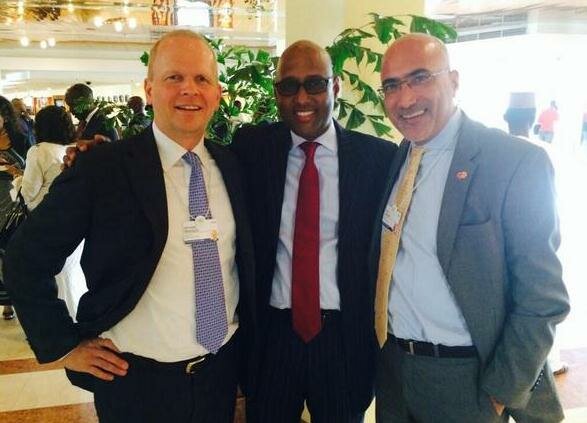
MasterCard’s Michael Miebach and Sami Lahoud with HE Adan Mohamed, Kenyan Minister of Industrialization (centre)
Sami Lahoud, vice president of communications in the Middle East and Africa (MEA) for MasterCard, explains how new technologies, including biometrics, can play a role in financial inclusion on the continent.
This week, MasterCard joins more than 1,000 business leaders, heads of state and government, as well as representatives from academia, development organisations, non-profits and media in Abuja, Nigeria for the 24th World Economic Forum(WEF) on Africa. The theme for this year’s meeting is “Forging Inclusive Growth; Creating Jobs”.
Africa has enjoyed considerable economic development, particularly in the last 10 years and today, the continent’s economic prospects remain positive with 5.3 per cent growth predicted for 2014, according to an African Economic Outlookreport. Yet, the continent has been faced with unemployment, income inequalities, poverty, and in some markets, poor health and education systems.
Reminders of the realities of Africa’s challenges should not diminish the optimism felt by those who live, work and invest here. Rather, these reminders indicate the importance of our ongoing efforts to ensure that growth in Africa does not occur for its own sake. What we are working towards – and what we are at WEF to discuss and solve for – is ensuring that growth is inclusive and transformative.
A key contributor to inclusive development is financial inclusion, an area in which Africa has been lagging behind other continents, as less than a quarterof adults have an account with a formal financial institution.
In the current paradigm, financial inclusion is either treated as a pure CSR initiative or as a pure business case. MasterCard has created a new financial inclusion model based on what we refer to as: doing well (business case) by doing good (philanthropy case) – these need not be mutually exclusive but only if we create the right model for this new equation. This model is based on broad collaboration between the public and the private sector, as neither party can do it alone.
Innovations in payment technology – prepaid and mobile coupled with biometrics – play a key role as they can quickly bridge the gap between the formal financial services sector and the millions of low-income, underserved or unbanked individuals on the continent.
A great example is in Nigeria where the government launched a national ID programmethat combines a biometric identification solution with a prepaid payment functionality powered by MasterCard. It is the largest formal electronic payment solution in Nigeria and the broadest financial inclusion initiative of its kind on the African continent.













